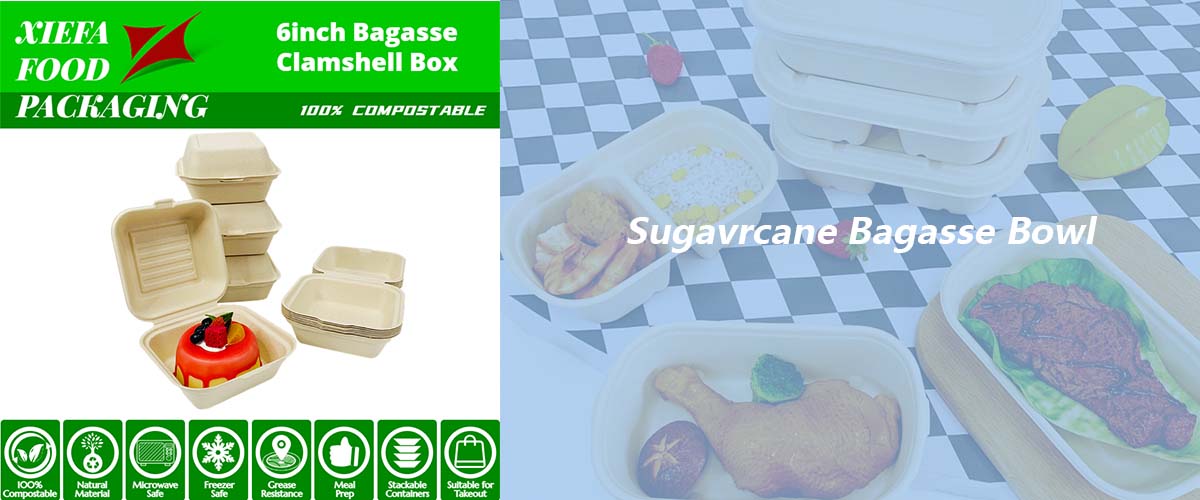
As the world continues to grapple with environmental issues and concerns, the need for more sustainable and eco-friendly alternatives to traditional products has become more pressing than ever. From plastic bags and straws to food containers and tableware, there is a growing demand for products that are renewable, biodegradable, and safe for the environment. One such product that has gained popularity in recent years is the sugarcane bagasse bowl.
What is Sugarcane Bagasse?
Sugarcane bagasse is the fibrous residue left after the juice is extracted from sugarcane. It is usually discarded as waste, but with the advent of new technologies and manufacturing processes, sugarcane bagasse has been transformed into a versatile and sustainable material that can be used for a variety of purposes, including food packaging and tableware.
Sugarcane bagasse is made up of cellulose, hemicellulose, and lignin, which are the primary components of plant cell walls. The fibers are strong, lightweight, and highly absorbent, making them ideal for use in a wide range of applications. Sugarcane bagasse is also renewable and biodegradable, meaning that it can be recycled or composted after use, reducing waste and pollution.
Advantages of Sugarcane Bagasse Bowls
There are many advantages to using sugarcane bagasse bowls over traditional plastic or paper bowls. Here are some of the key benefits:
-
Environmental Benefits
One of the primary advantages of sugarcane bagasse bowls is their environmental sustainability. They are biodegradable and compostable, meaning that they break down naturally in the environment, unlike plastic and paper products which can take hundreds of years to decompose. When sugarcane bagasse bowls are composted, they break down into organic matter, which can be used as a natural fertilizer to promote plant growth.
-
Reduced Waste and Pollution
Sugarcane bagasse bowls also help reduce waste and pollution in the environment. By using sugarcane bagasse instead of traditional plastic or paper products, we can reduce the amount of waste that ends up in landfills, where it can take hundreds of years to decompose. This, in turn, helps reduce greenhouse gas emissions, which contribute to climate change.
-
Renewable and Sustainable Resource
Sugarcane bagasse is a renewable resource, which means that it can be replenished naturally over time. It is also sustainable, meaning that it can be harvested and used without depleting the natural resources of the environment. By using sugarcane bagasse, we can help preserve our natural resources and reduce our reliance on non-renewable materials like fossil fuels.
-
Health and Safety Benefits
In addition to their environmental benefits, sugarcane bagasse bowls also provide health and safety benefits. Here are some of the key benefits:
-
Non-toxic and Chemical-free
Sugarcane bagasse bowls are non-toxic and chemical-free, meaning that they do not contain harmful substances that can leach into our food or drinks. This is especially important for hot or acidic foods and beverages, which can cause plastic or paper products to release harmful chemicals into our food or drinks.
-
Microwave and Refrigerator Safe
Sugarcane bagasse bowls are also microwave and refrigerator safe, making them convenient for reheating or storing food. Unlike plastic products, which can melt or warp when heated, sugarcane bagasse bowls maintain their shape and integrity when exposed to high temperatures.
-
Heat and Cold Resistance
Sugarcane bagasse bowls are resistant to both heat and cold, making them ideal for use in a wide range of applications. They can withstand temperatures ranging from -20°C to 220°C, which means that they can be used to serve both hot and cold food items without the risk of melting or breaking.
-
Versatile and Stylish
Sugarcane bagasse bowls come in various shapes, sizes, and designs, making them a versatile and stylish option for food packaging and tableware. They can be used for a variety of purposes, including serving soups, salads, desserts, and other food items. Sugarcane bagasse bowls can also be customized with logos or designs, making them ideal for use in restaurants, cafes, and other food service establishments.
Production Process of Sugarcane Bagasse Bowls
The production process of sugarcane bagasse bowls involves several steps, including harvesting, pulping, and molding.
-
Harvesting
Sugarcane is harvested using mechanical harvesters or manually with machetes. The sugarcane stalks are then transported to the processing plant.
-
Pulping
At the processing plant, the sugarcane stalks are crushed to extract the juice, leaving behind the fibrous residue, or bagasse. The bagasse is then washed and purified to remove impurities, such as dirt and debris.
-
Molding
Once the bagasse is purified, it is molded into bowls using a process called thermoforming. Thermoforming involves heating the bagasse fibers until they become pliable, then shaping them into bowls using molds. The molded bowls are then cooled and trimmed to the desired size and shape.
After the molding process, the sugarcane bagasse bowls are inspected for quality and safety before being packaged and shipped to customers.
Uses of Sugarcane Bagasse Bowls
Sugarcane bagasse bowls are versatile and can be used in a variety of applications, including:
-
Food Packaging
Sugarcane bagasse bowls are ideal for food packaging, as they are lightweight, durable, and can be sealed to keep food fresh. They are commonly used for packaging fast food items, take-out meals, and deli products.
-
Food Service
Sugarcane bagasse bowls are also ideal for food service, as they are stylish, eco-friendly, and convenient. They can be used to serve a wide range of food items, from soups and salads to desserts and snacks.
-
Events and Parties
Sugarcane bagasse bowls are perfect for events and parties, as they are disposable, easy to use, and eco-friendly. They can be used to serve food and beverages at weddings, birthdays, and other celebrations.
-
Composting and Recycling
Sugarcane bagasse bowls can be composted or recycled after use, making them an eco-friendly option for food packaging and tableware. When composted, sugarcane bagasse bowls break down naturally in the environment, providing valuable nutrients for plants and soil. When recycled, they can be transformed into new products, reducing waste and conserving resources.
Conclusion
Sugarcane bagasse bowls are a sustainable and eco-friendly alternative to traditional plastic and paper products. They provide numerous environmental, health, and safety benefits, making them an ideal option for food packaging and tableware. The production process of sugarcane bagasse bowls is also sustainable and responsible, preserving natural resources and reducing waste and pollution.
As consumers become more aware of the impact of their choices on the environment, the demand for sustainable and eco-friendly products will continue to grow. Sugarcane bagasse bowls are just one example of how innovative technology and manufacturing processes can transform waste into a valuable resource, creating a more sustainable and responsible future for all.
